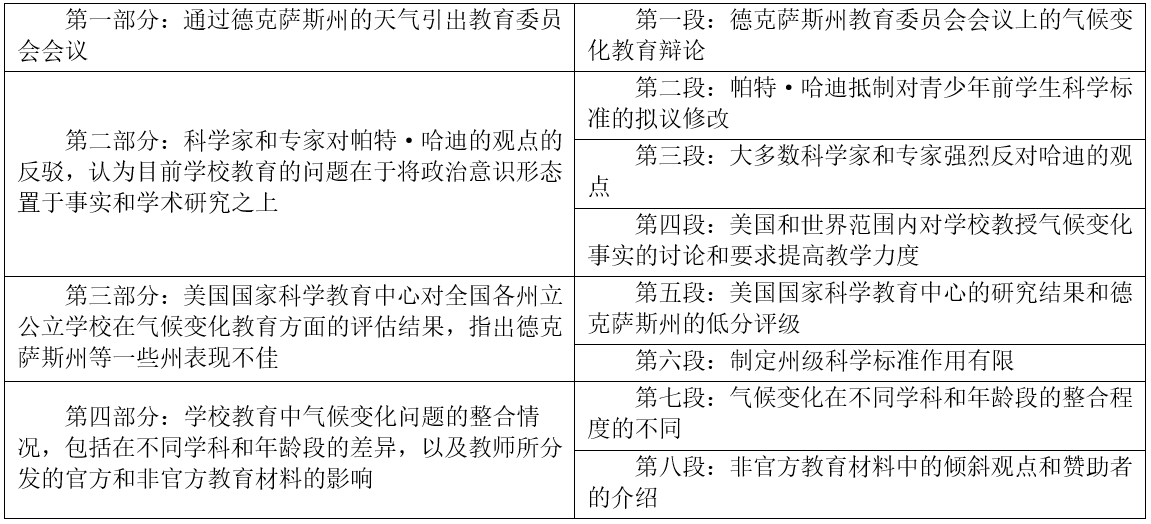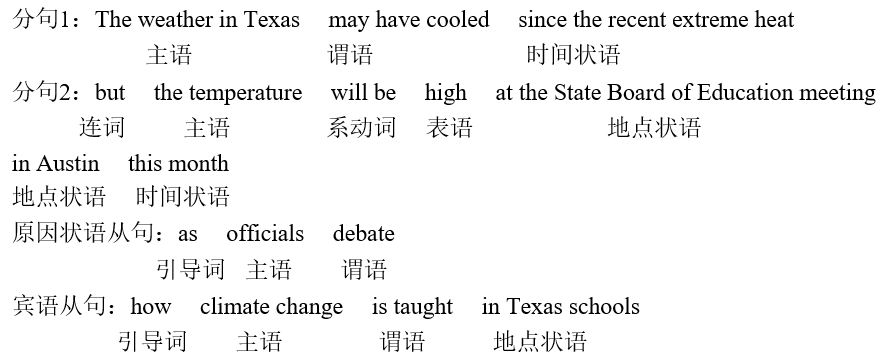The weather in Texas may have cooled since the recent extreme heat, but the temperature will be high at the State Board of Education meeting in Austin this month as officials debate how climate change is taught in Texas schools.
Pat Hardy, who sympathized with views of the energy sector, is resisting the proposed change to science standards for pre-teen pupils. These would emphasize the primacy of human activity in recent climate change and encourage discussion of mitigation measures.
Most scientists and experts sharply dispute Hardy’s views. “They casually dismiss the career work of scholars and scientists as just another misguided opinion.” says Dan Quinn, senior communications strategist at the Texas Freedom Network, a non-profit group that monitors public education, “What millions of Texas kids learn in their public schools is determined too often by the political ideology of partisan board members, rather than facts and sound scholarship.”
Such debate reflects fierce discussions across the US and around the world, as researchers, policymakers, teachers and students step up demands for a greater focus on teaching about the facts of climate change in schools.
A study last year by the National Center for Science Education, a non-profit group of scientists and teachers, looking at how state public schools across the country address climate change in science classes, gave barely half of US states a grade B+ or higher. Among the 10 worst performers were some of the most populous states, including Texas, which was given the lowest grade F and has a disproportionate influence because its textbooks are widely sold elsewhere.
Glenn Branch, the center’s deputy director, cautions that setting state-level science standards is only one limited benchmark in a country that decentralizes decisions to local school boards. Even if a state is considered a high performer in its science standards, “that does not mean it will be taught”, he says.
Another issue is that while climate change is well integrated into some subjects and at some ages—such as earth and space sciences in high schools it is not as well represented in curricula for younger children and in subjects that are more widely taught, such as biology and chemistry. It is also less prominent in many social studies courses.
Branch points out that, even if a growing number of official guidelines and textbooks reflect scientific consensus on climate change, unofficial educational materials that convey more slanted perspectives are being distributed to teachers. They include materials sponsored by libertarian think-tanks and energy industry associations.
1. In Paragraph 1, the weather in Texas is mentioned to ________.
2. What does Quinn think of Hardy?
3. The study mentioned in Paragraph 5 shows that ________.
4. According to Branch, state-level science standards in the US ________.
5. It is implied in the last paragraph that climate change teaching in some schools ________.
问题1选项
A.forecast a policy shift in Texas schools
B.stress the consequences of climate change
C.indicate the atmosphere at the board meeting
D.draw the public’s attention to energy shortages
问题2选项
A.She exaggerates the existing panic.
B.She denies the value of scientific work.
C.She shows no concern for pre-teens.
D.She expresses self-contradictory views.
问题3选项
A.climate education is insufficient at state public schools
B.policy makers have little drive for science education
C.Texas is reluctant to rewrite its science textbooks
D.environmental teaching in some states lacks supervision
问题4选项
A.call for regular revision
B.require urgent application
C.have limited influence
D.cater to local needs
问题5选项
A.agree to major public demands
B.reflects teachers’ personal biases
C.may misrepresent the energy sector
D.can be swayed by external forces
第1题:C
第2题:B
第3题:A
第4题:C
第5题:D
第1题:
【整体分析】
来源:Financial Times(《金融时报》)于2021年11月1日刊登的文章Schools Face Calls to Boost Environmental Teaching(学校面临着加强环境教学的呼声)。
主题:本文主要讨论了围绕德克萨斯州学校气候变化教学的争论。州教育委员会成员帕特·哈迪反对科学课程的改革,非营利组织和教育工作者呼吁加强气候变化方面的教育。然而,人们仍然担心政治意识形态和有偏见的教育材料对教学的影响。
结构:

【选项释义】
In Paragraph 1, the weather in Texas is mentioned to ________. 在第1段中,提到德州的天气是为了________。
A. forecast a policy shift in Texas schools A. 预测德克萨斯学校的政策转变
B. stress the consequences of climate change B. 强调气候变化的后果
C. indicate the atmosphere at the board meeting C. 表明董事会会议上的气氛
D. draw the public’s attention to energy shortages D. 引起公众对能源短缺的注意
【考查点】推理判断题。
【解题思路】根据题干关键词the weather in Texas可以定位到文章第一段“自最近的极端高温以来,德克萨斯州的天气可能已经降温,但本月在奥斯汀举行的州教育委员会会议上,温度将居高不下(the temperature will be high at the State Board of Education meeting),官员们将就德克萨斯州的学校如何教授气候变化进行辩论”,说明文章提到德克萨斯州的天气是为了与会议的气氛进行对比,反衬出会议上讨论的气氛非常热烈。因此C选项“表明董事会会议上的气氛”正确。
【干扰项排除】
A选项“预测德克萨斯学校的政策转变”,B选项“强调气候变化的后果”和D选项“引起公众对能源短缺的注意”在文中均无法体现,属于无中生有。
第2题:
【选项释义】
What does Quinn think of Hardy? 奎因对哈迪有什么看法?
A. She exaggerates the existing panic. A. 她夸大了现有的恐慌。
B. She denies the value of scientific work. B. 她否定了科学工作的价值。
C. She shows no concern for pre-teens. C. 她没有表现出对青少年前学生的关注。
D. She expresses self-contradictory views. D. 她表达了自相矛盾的观点。
【考查点】事实细节题。
【解题思路】根据题干关键词Quinn think of Hardy可以定位到文章第三段第二句“德州自由网络的高级传播策略师丹·奎因说:‘他们随意地将学者和科学家的职业工作视为另一种被误导的观点(casually dismiss the career work of scholars and scientists as just another misguided opinion)’”,说明奎因认为哈迪轻视学者和科学家的工作,否认了他们的工作价值。因此B选项“她否定了科学工作的价值。”正确。
【干扰项排除】
A选项“她夸大了现有的恐慌。”和D选项“她表达了自相矛盾的观点。”在文中没有提及,属于无中生有;
C选项“她没有表现出对青少年前学生的关注。”,由Pat Hardy, who sympathized with views of the energy sector, is resisting the proposed change to science standards for pre-teen pupils.(帕特·哈迪对能源部门的观点表示理解,她正在抵制对青少年前学生科学标准的拟议修改。)可知,哈迪是关注青少年前学生的,属于反向干扰。
第3题:
【选项释义】
The study mentioned in Paragraph 5 shows that ________. 第5段中提到的研究表明:________。
A. climate education is insufficient at state public schools A. 州公立学校的气候教育是不够的
B. policy makers have little drive for science education B. 政策制定者对科学教育缺乏动力
C. Texas is reluctant to rewrite its science textbooks C. 德州不愿意重写科学教科书
D. environmental teaching in some states lacks supervision D. 一些州的环境教学缺乏监督
【考查点】推理判断题。
【解题思路】根据题干关键词study可以定位到文章第五段第一句“由科学家和教师组成的非营利组织——美国国家科学教育中心去年进行了一项研究,考察了全国各州立公立学校在科学课上如何处理气候变化问题,结果只对美国仅仅一半的州给出了B+或更高的评分(gave barely half of US states a grade B+ or higher)”,说明美国国家科学教育中心对一半的州公立学校的气候教育评价不高,这意味着州公立学校的气候教育是不够的。因此A选项“州公立学校的气候教育是不够的”正确。
【干扰项排除】
B选项“政策制定者对科学教育缺乏动力”,由researchers, policymakers, teachers and students step up demands for a greater focus on teaching about the facts of climate change in schools(研究人员、政策制定者、教师和学生都提出了更高的要求,要求在学校加大对气候变化事实的教学力度)可知,政策制定者有动力追求科学教育,属于反向干扰;
C选项“德州不愿意重写科学教科书”和D选项“一些州的环境教学缺乏监督”在文中没有提及,属于无中生有。
第4题:
【选项释义】
According to Branch, state-level science standards in the US ________. 根据布兰奇的说法,美国的州级科学标准________。
A. call for regular revision A. 需要定期修订
B. require urgent application B. 需要迫切应用
C. have limited influence C. 影响力有限
D. cater to local needs D. 迎合了当地需求
【考查点】事实细节题。
【解题思路】根据题干关键词Branch可以定位到文章第六段第一句“该中心副主任格伦·布兰奇警告说,在一个将决策权下放给地方学校董事会的国家,制定州级科学标准只是一个有限的基准(only one limited benchmark)”,说明布兰奇认为美国的州级科学标准的作用有限。因此C选项“影响力有限”正确。
【干扰项排除】
A选项“需要定期修订”,B选项“需要迫切应用”和D选项“迎合了当地需求”在文中均没有提及,属于无中生有。
第5题:
【选项释义】
It is implied in the last paragraph that climate change teaching in some schools ________. 在最后一段中暗示,一些学校的气候变化教学________。
A. agree to major public demands A. 接受了主要的公众要求
B. reflects teachers’ personal biases B. 反映了教师的个人偏见
C. may misrepresent the energy sector C. 可能歪曲了能源部门的情况
D. can be swayed by external forces D. 可能被外部力量所动摇
【考查点】推理判断题。
【解题思路】根据题干关键词the last paragraph可以定位到文章最后一段“向教师分发的非官方教育材料却传达了更多的倾斜观点(convey more slanted perspectives)。其中包括由自由主义智库和能源产业协会赞助的材料(materials sponsored by libertarian think-tanks and energy industry associations)”,说明一些学校的气候变化教学接受了自由主义智库和能源产业协会赞助的材料,所以可能会受到这些外部力量的影响。因此D选项“可能被外部力量所动摇”正确。
【干扰项排除】
A选项“接受了主要的公众要求”,B选项“反映了教师的个人偏见”和C选项“可能歪曲了能源部门的情况”在文中均没有提及,属于无中生有。
【重点词汇】
extreme /ɪkˈstriːm/ adj. 极端的
primacy /ˈpraɪməsi/ n. 卓越;至高无上;第一位
mitigation /ˌmɪtɪˈɡeɪʃn/ n. 缓解;减轻
fierce /fɪəs/ adj. 激烈的;凶猛的
partisan /ˈpɑːrtɪzn/ adj. 党派的;偏袒的
populous /ˈpɒpjʊləs/ adj. 人口稠密的
decentralize /diːˈsentrəlaɪz/ v. 分散;去中心化
prominent /ˈprɒmɪnənt/ adj. 突出的;重要的
consensus /kənˈsensəs/ n. 共识;一致
libertarian /ˌlɪbəˈteriən/ adj. 自由主义的;无政府主义的
benchmark /ˈbentʃmɑːk/ n. 基准;标准
slanted /ˈslæntɪd/ adj. 有偏见的;倾斜的
pre-teen (指儿童)11岁以下的
think-tank 智囊团;智库
【长难句分析】
1. The weather in Texas may have cooled since the recent extreme heat, but the temperature will be high at the State Board of Education meeting in Austin this month as officials debate how climate change is taught in Texas schools.
【结构分析】

【补充分析】
① as引导原因状语从句,说明会议的温度之所以高,是因为官员们在辩论;
② how引导宾语从句作debate的宾语,进一步解释了官员们辩论的具体内容。
【参考译文】自最近的极端高温以来,德克萨斯州的天气可能已经降温,但本月在奥斯汀举行的州教育委员会会议上,温度将居高不下,因为官员们就德克萨斯州的学校如何教授气候变化进行辩论。
2. A study last year by the National Center for Science Education, a non-profit group of scientists and teachers, looking at how state public schools across the country address climate change in science classes, gave barely half of US states a grade B+ or higher.
【结构分析】

【补充分析】
① last year是后置定语,修饰前面的study,指明这个研究是去年进行的;
② by the National Center for Science Education是介词短语作后置定语修饰study,表明这个研究是由美国国家科学教育中心进行的;
③ a non-profit group of scientists and teachers作the National Center for Science Education的同位语,说明美国国家科学教育中心是一个由科学家和教师组成的非营利组织;
④ looking at是现在分词短语作study的后置定语,进一步描述了该研究的内容;
⑤ how引导宾语从句,作looking at的宾语,表示考察的范围是全国的公立学校在科学课上如何教授气候变化这一问题。
【参考译文】由科学家和教师组成的非营利组织——美国国家科学教育中心去年进行了一项研究,考察了全国各州立公立学校在科学课上如何处理气候变化问题,结果只对美国仅仅一半的州给出了B+或更高的评分。
【全文翻译】
自最近的极端高温以来,德克萨斯州的天气可能已经降温,但本月在奥斯汀举行的州教育委员会会议上,温度将居高不下,因为官员们就德克萨斯州的学校如何教授气候变化进行辩论。
帕特·哈迪对能源部门的观点表示理解,她正在抵制对青少年前学生科学标准的拟议修改。这将强调人类活动在最近气候变化中的首要作用,并鼓励讨论缓解措施。
大多数科学家和专家强烈反对哈迪的观点。德州自由网络的高级传播策略师丹·奎因说:“他们随意地将学者和科学家的职业工作视为另一种被误导的观点。”德州自由网络是一个监督公共教育的非营利组织,“数百万德克萨斯州孩子在公立学校学到的东西,往往是由党派董事会成员的政治意识形态决定的,而不是事实和可靠的学术研究。”
这样的辩论反映了美国和世界各地的激烈讨论,研究人员、政策制定者、教师和学生都提出了更高的要求,要求在学校加大对气候变化事实的教学力度。
由科学家和教师组成的非营利组织——美国国家科学教育中心去年进行了一项研究,考察了全国各州立公立学校在科学课上如何处理气候变化问题,结果只对美国仅仅一半的州给出了B+或更高的评分。在表现最差的10个州中,有一些是人口最多的州,包括德克萨斯州,它被评为最低的F,但由于其教科书在其他地方广泛销售,因此具有不成比例的影响。
该中心副主任格伦·布兰奇警告说,在一个将决策权下放给地方学校董事会的国家,制定州级科学标准只是一个有限的基准。他说,即使一个州被认为在科学标准方面表现出色,“这并不意味着它会被教授”。
另一个问题是,尽管气候变化在某些学科和某些年龄段得到了很好的整合——比如高中的地球和空间科学——但在低龄儿童课程和更广泛教授的学科(如生物和化学)中却没有得到很好的体现。它在许多社会研究课程中也不那么突出。
布兰奇指出,即使越来越多的官方指导方针和教科书反映了关于气候变化的科学共识,但向教师分发的非官方教育材料却传达了更多的倾斜观点,其中包括由自由主义智库和能源产业协会赞助的材料。